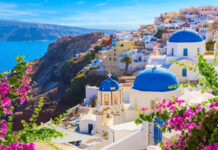The world is full of majestic architectural sights and monuments whose beautiful and artistic architectural works attract people from all over the world. One such monument is the Hagia Sophia Museum. Situated in Fatih, Istanbul, Turkey, the monument is a symbol of harmony, peace, and tolerance in Turkey and was built in the sixth century. This glorious landmark has seen Turkey through years in different phases of its development. From an Orthodox Church to the rise and fall of the Ottoman empire, it has seen it all The cities of Turkey not only represent a glorious skyline and rich culture but also reminds one of its ethnic and exotic past and its rulers. The ravishing walls of Hagia Sophia represent the combination of Islamic art and Christianity as it has been a mosque for 482 years and church for more than 9 centuries. It is one of the most important and significant Byzantine structures in the world.
The structure of the Hagia Sophia Museum consists of two floors with giant 32-meter dome ceiling naves and gold mosaics with two smaller domes towering above. The floor of the Hagia Sophia demonstrates a symmetrical design. The Hagia Sophia was built under the directions of Emperor Justinian I as a basilica for the Greek Orthodox Church but has since seen several functional changes.
The monument was not always the same as it stands today. It first featured a wooden roof. In 404 A.D, the structure was burned down during the riots in Constantinople due to the problems within the royal family of the then- Emporer, Arkadios. The structure was then rebuilt by the successor of Arkadios, Emperor Theodosios, and was completed in 415. However, over a century later, the structure was burned again during the “Nika-Revolts” against Emperor Justinian I, whose reign was from 527 to 565.
The damage caused to Hagia Sophia by the fire was irreparable and was hence ordered to be demolished by the Emperor. Hagia Sophia was rebuilt and completed in 537 for the third time. The first religious procession is said to be held at the “new” Hagia Sophia in the December of 537.
After Constantinople was conquered by the Ottoman, Hagia Sophia was converted into a mosque by Mehmed II in the year 1453. A wooden minaret, a mihrab, that showed the direction to the holy city of Mecca, and a large chandelier along with uniques Islamic calligraphy were added to the structure. It is believed the calligraphy present in the Hagia Sophia is one of its only kind and does not exist in any other mosque around the world. however, the depiction of Jesus Christ, mother Marry, and other representations of Christianity were not harmed or destroyed in the process. The carvings on walls show the artistic and creative sense of the architects from the time it was made.
The conquest of Constantinopole made Hagia Sophia an important place for the top-ranked Ottoman families to worship and visit. It became of great significance for the Ottoman empire.
Hagia Sophia was secularized in 1934 by then Turkish President Kemal Atatürk and was made into a museum in 1935 to build a secular country as a part of his reforms so that the structure could serve as a multifaith and depict the multicultural past of Turkey. The architectural features of the monument and its depiction of both Christianity and Islamic art make it an architectural masterpiece. Its long-standing architecture has also served as n inspiration for several mosques in Turkey and other parts of the world. It also served as a school, library, and fountain and continues to resonate grace and beauty. The walls of Hagia Sophia would have quite a lot of stories to tell if they could talk. The glorious past of the landmark is remembered by people across the world. Each wall, each carving carefully designed and stored is now protected.
Hagia Sophia, today is considered a UNESCO heritage site since 1985. Even after the fall of the Ottoman Empire, Hagia Sophia plays an important role in both politics and religion. In July of 2020, the Turkish council of state reclassified Hagia Sophia as a mosque due to pressure from nationalists and other groups. Artists from around the world look up to Hagia Sophia for inspiration for their art. Hagia Sophia is Turkey’s most visited monumental site today and is admired by millions around the world. It is not only visited by tourists from around the world but also archeologists, students, and researchers and is open for visitors who wish to witness its scenic beauty.
By Advika Sahai











